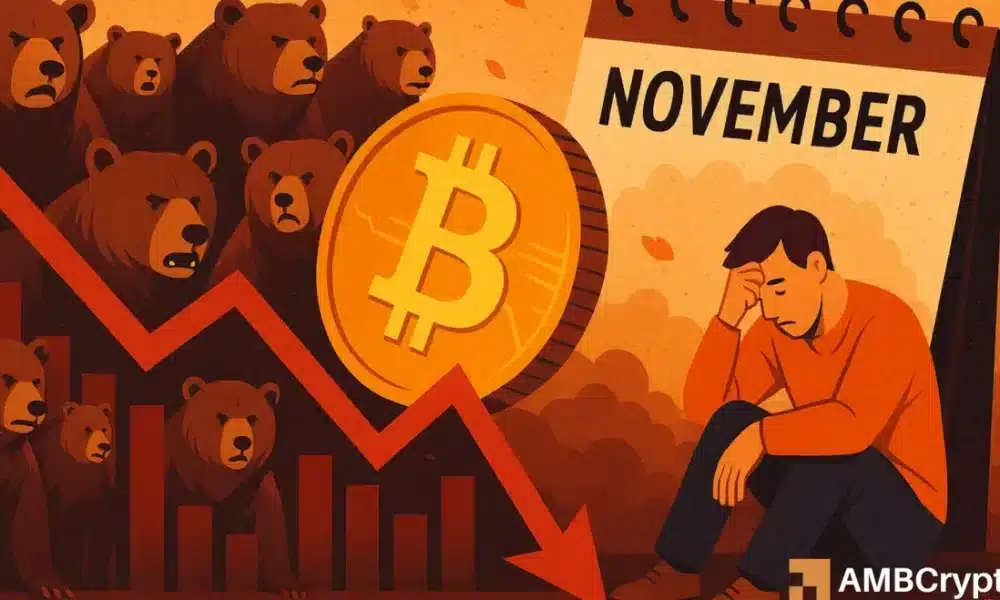Bitcoin ETFs Experience Significant Withdrawals: Insights and Implications
In November, Bitcoin Exchange-Traded Funds (ETFs) faced unprecedented outflows, reflecting a growing sense of caution among investors. This article explores the factors driving these withdrawals, particularly focusing on the substantial movements seen from key funds and the broader implications for the cryptocurrency market.
Major Withdrawals Leading ETF Outflows
The current climate for Bitcoin ETFs has been tumultuous, particularly highlighted by a single day of massive withdrawals on November 20th. Leading the charge, BlackRock’s iShares Bitcoin Trust (IBIT) experienced outflows of $355 million in just one day, while Grayscale’s Bitcoin Trust (GBTC) recorded approximately $199 million in exits. Combined, these withdrawals contributed to a staggering total of $903.2 million in outflows for the entire ETF segment on that specific day. Over the course of November, U.S. spot Bitcoin ETFs collectively faced nearly $3 billion in net outflows, presenting one of the industry’s most challenging months in recent history.
The Price Drop: Primary Culprit or Just One of Many Factors?
While the descent in Bitcoin’s price undeniably played a role in these ETF outflows—especially with a 7.35% drop within 24 hours—it’s essential to recognize that the volatility does not solely dictate investor sentiment. Historical data suggests that ETF flows and Bitcoin price movements do not always correlate. For instance, during a recovery phase in late October 2025, Bitcoin ETFs observed net inflows totaling $202 million despite the asset’s recent declines. This indicates that investor decisions are influenced by a confluence of market conditions, institutional strategies, and macroeconomic factors, in addition to the immediate price action of Bitcoin.
Contextualizing Market Trends
The recent downturn aligns with a broader trend of decreasing investor risk appetite, exacerbated by fears surrounding a potential AI-driven tech bubble and wavering expectations regarding U.S. interest rate cuts. Bitcoin’s price dropped notably from its Q3 peak of approximately $126,000, and the fluctuation resulted in a shift from ten consecutive days of inflows to relentless outflows by the month of November. An analysis by CoinSwitch Markets Desk suggests that the next significant price cluster could form between $78,000 and $75,000, a zone where historical trends show increased buyer activity.
Institutional Strategies and Changing Risk Appetite
The withdrawal trend reflects a larger sentiment shift within the market. Following substantial inflows earlier in the year, Q4 introduced a contrasting narrative, characterized by persistent bearish trends. Factors such as shifting institutional strategies, evolving macroeconomic conditions, and apprehensive investor sentiment all contribute to the current scenario. This cautious attitude has impacted Bitcoin societies and related funds, indicating that sentiment rather than fundamental structural issues may be primarily driving the outflows.
Implications for Future Market Movements
Despite recent challenges, analysts suggest that the market downturn is sentiment-driven and potentially temporary. There’s an underlying belief that buy zones typically attract investment once prices stabilize. The historical context of forced selling followed by recovery further emphasizes the likelihood of Bitcoin bouncing back once it hits key support levels. This cyclical behavior in the crypto market means that despite the current hardships, there’s potential for future recoveries, depending on broader economic indicators and the evolving regulatory landscape.
Conclusion: Navigating Uncertainty in the Bitcoin ETF Landscape
As we navigate a landscape marked by significant ETF withdrawals and declining Bitcoin prices, it’s crucial for investors to remain informed and adaptable. This tumultuous phase in November serves as a reminder of the complexities within cryptocurrency investments. While price movements can evoke immediate reactions, the factors influencing ETF flows are multifaceted. Understanding these dynamics will be key for both individual and institutional investors looking to make informed decisions in this ever-evolving market. As we look to the future, vigilance and adaptability will remain essential for navigating the uncertainties ahead.
















